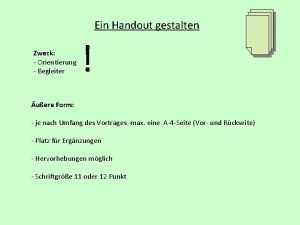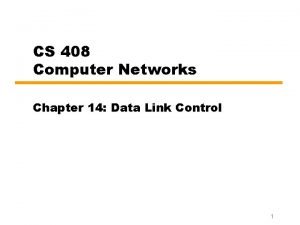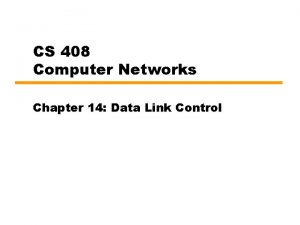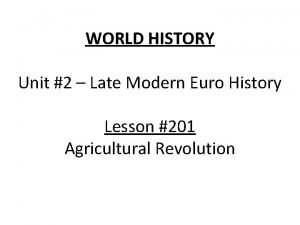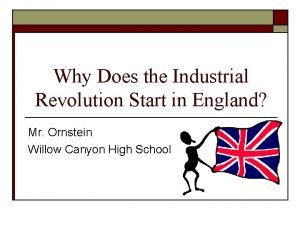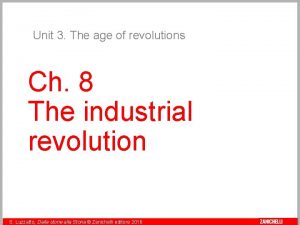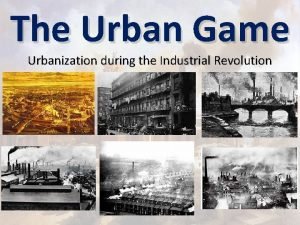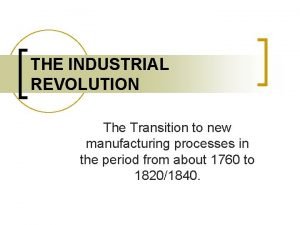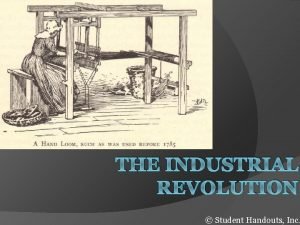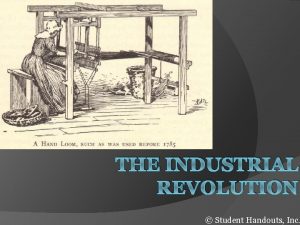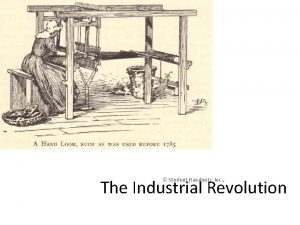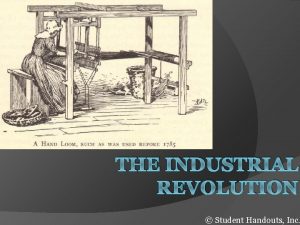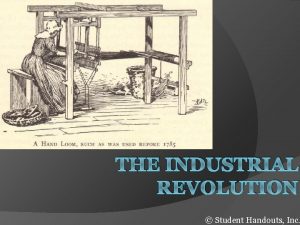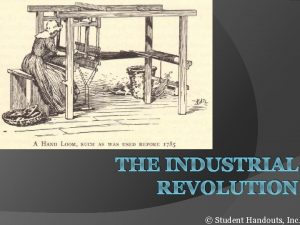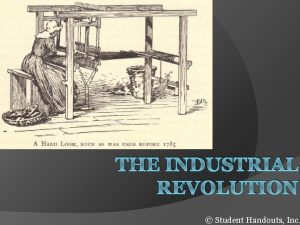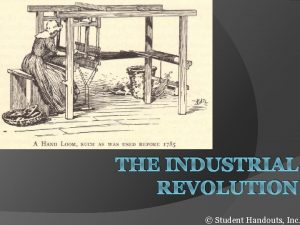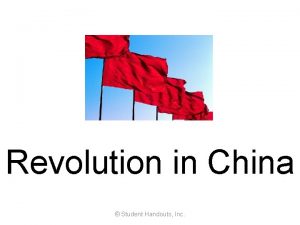THE INDUSTRIAL REVOLUTION Student Handouts Inc What was























- Slides: 23

THE INDUSTRIAL REVOLUTION © Student Handouts, Inc.

What was the Industrial Revolution? The Industrial Revolution was a fundamental change in the way goods were produced, from human labor to machines The more efficient means of production and subsequent higher levels of production triggered far-reaching changes to industrialized societies

The Industrial Revolution Machines were invented which replaced human labor New energy sources were developed to power the new machinery – water, steam, electricity, oil (gas, kerosene) Some historians place advances in atomic, solar, and wind energy at the later stages of the Industrial Revolution Increased use of metals and minerals Aluminum, coal, copper, iron, etc.

The Industrial Revolution Transportation improved Ships ○ Wooden ships → Iron ships → Steel ships ○ Wind-powered sails → Steam-powered boilers Trains Automobiles Communication improved Telegraph Telephone Radio

Developments Mass production of goods Increased numbers of goods Increased diversity of goods produced Development of factory system of production Rural-to-urban migration People left farms to work in cities Development of capitalism Financial capital for continued industrial growth Development and growth of new socio-economic classes Working class, bourgeoisie, and wealthy industrial class Commitment to research and development Investments in new technologies Industrial and governmental interest in promoting invention, the sciences, and overall industrial growth


Why the Industrial Revolution Started in England Capital for investing in the means of production Colonies and Markets for manufactured goods Raw materials for production Workers Merchant marine Geography

Development of Steam Engines Early water power involved mills built over fast-moving streams and rivers Early water power had problems Not enough rivers to provide the power needed to meet growing demand Rivers and streams might be far removed from raw materials, workers, and markets Rivers are prone to flooding and drying

Steam Engines By 1800, steam engines were replacing water wheels as sources of power for factories Factories relocated near raw materials, workers, and ports Cities grew around the factories built near central England’s coal and iron mines Manchester, Liverpool

Transportation Increased production Search for more markets and raw materials Before the Industrial Revolution • Canal barges pulled by mules • Ships powered by sails • Horse-drawn wagons, carts, and carriages After the Industrial Revolution • Trains • Steamships • Trolleys • Automobiles Better and faster means of transportation


Agriculture and Industry The Industrial Revolution brought machinery to farms The use of farm machinery meant that fewer farm workers were needed Displaced farm workers moved to the cities to find work in factories This is called rural-to-urban migration Growing populations in urban cities required farmers to grow more crops Food to eat Raw materials (like cotton) for textile factories

THE RESULTS OF THE INDUSTRIAL REVOLUTION

Results of the Industrial Revolution Economic Changes • Expansion of world trade • Factory system • Mass production of goods • Industrial capitalism • Increased standard of living • Unemployment Political Changes • Decline of landed aristocracy • Growth and expansion of democracy • Increased government involvement in society • Increased power of industrialized nations • Nationalism and imperialism stimulated • Rise to power of businesspeople Social Changes • Development and growth of cities • Improved status and earning power of women • Increase in leisure time • Population increases • Problems – economic insecurity, increased deadliness of war, urban slums, etc. • Science and research stimulated

Problems of the Factory System Factories were crowded, dark, and dirty Workers toiled from dawn to dusk Young children worked with dangerous machinery Employment of women and children put men out of work Women and children were paid less for the same work Technological unemployment – workers lost their jobs as their labor was replaced by machines

Poor Living Conditions Factories driven solely by profit Businesses largely immune to problems of workers Factory (also company or mill) towns Towns built by employers around factories to house workers Workers charged higher prices than normal for rent, groceries, etc. ○ Workers often became indebted to their employers ○ Created a type of forced servitude as workers had to stay on at their jobs to pay their debts Considered paternalistic by workers ○ Some employers had workers’ interests at heart ○ But workers wanted to control their own lives


THE LABOR MOVEMENT

Changing Employee-Employer Relationships Domestic system Workers and employers knew each other personally Workers could aspire to become employers Factory system Workers no longer owned the means of production (machinery) Employers no longer knew workers personally ○ Factories often run by managers paid by the corporation Relationships between employers and employees grew strained

Slum Living Conditions Factory towns – often built and owned by factories Not a strange concept to rural-to-urban migrants who were used to living on a lord’s estate or property Full of crowded tenements Few amenities Tenements – buildings with rented multiple dwellings Apartment buildings with a more negative connotation Overcrowded and unsanitary Workers were unsatisfied both inside and outside the factories

Rise of Labor Unions Before labor unions, workers bargained individually – “individual bargaining” Before factories, a worker could bargain for better wages and working conditions by arguing his or her particular skills But in factories, work is routine and one worker can easily replace another With labor unions, workers bargained together as a group, or collective – “collective bargaining” Organized groups of workers elected leaders to bargain on their behalf Used tools (such as strikes) to gain rights

Weapons Used by Unions and Employers Weapons Used by Employers • • • • At-will employment Blacklists Company unions Individual bargaining Injunctions Laws that limit union activities Lockouts Open shops Outsourcing Relocation Right-to-work laws Threat of foreign competition Welfare capitalism Yellow-dog contracts Weapons Used by Unions • • • • Boycotts Check-offs Closed shops Collective bargaining Direct political action Favorable labor legislation Feather-bedding Lobbying Picketing Sabotage Strikes Union label Union shops

Legal Protections for Workers Limited hours for women Later – equal pay for equal work Eventual end to child labor Schools and requirements for school attendance grew as children were removed from the workforce Health and safety codes Minimum wage Legalization of unions
 Studenthandouts.com
Studenthandouts.com Student handouts.com
Student handouts.com Student handouts inc
Student handouts inc Zoo103 handouts pdf
Zoo103 handouts pdf Jane schaffer color coding
Jane schaffer color coding Sample of handouts
Sample of handouts Handout gestalten schule
Handout gestalten schule Cs408 handouts
Cs408 handouts Cs408 handouts
Cs408 handouts Definition of handouts
Definition of handouts Gapped handouts
Gapped handouts Advantages and disadvantages of handouts
Advantages and disadvantages of handouts Patient education template
Patient education template Advantages and disadvantages of handouts
Advantages and disadvantages of handouts Russian revolution vs french revolution
Russian revolution vs french revolution You should hope this game will be over soon
You should hope this game will be over soon Definition of third agricultural revolution
Definition of third agricultural revolution Enclosure movement industrial revolution
Enclosure movement industrial revolution Why did the industrial revolution start in britain
Why did the industrial revolution start in britain Zanichelli
Zanichelli Urban game industrial revolution
Urban game industrial revolution Enclosure movement industrial revolution
Enclosure movement industrial revolution When was the loom invented
When was the loom invented Industrial revolution transition
Industrial revolution transition






